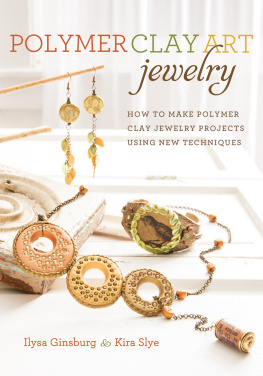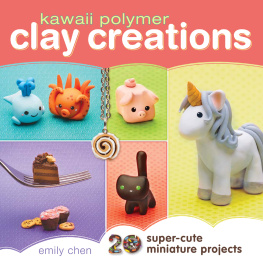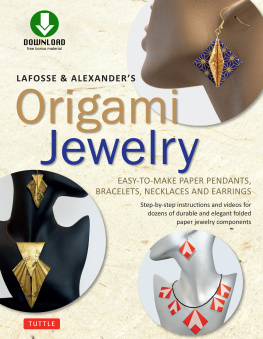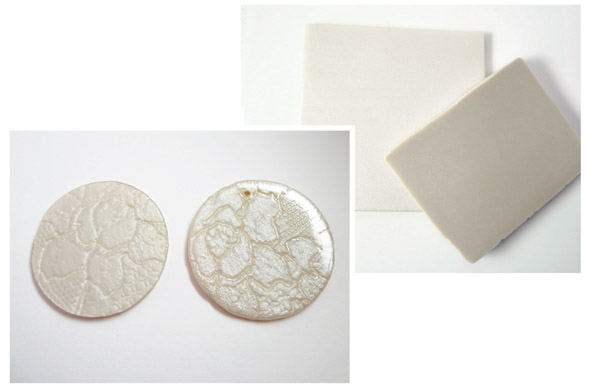General Techniques
Polymer clay is a type of craft modeling clay that hardens after about half an hour in a household oven. It is sold in blocks of different sizes and colors, which can be mixed with each other, offering an infinite range of colors. It is easy to work with: You can mold it with your hands or with little tools, add texture with stamps or textured materials, mix in little elements such as sequins, and even decorate it with paint, ink, or patina. In short, the possibilities for transforming this medium are so great it seems impossible to explore them all. This is doubtless what makes it so interesting: There are always new things to discover!
Depending on personal experience, a project that seems simple to some people may seem more complex to others, which is completely normal. Follow your instincts and start with the projects that seem most accessible to you. There will always be time to add complexity to your creations bit by bit when you are more comfortable with this medium. In this book, I give you some easy projects that will help you get started (*) and some that are more complex (** and ***). Without going too fast, take on some projects from a higher difficulty level than you feel capable ofthats how youll improve!
WHICH POLYMER CLAY SHOULD I CHOOSE?
Brands
The choice of brand is important. Far from wanting to convince you to get all your supplies from this manufacturer rather than that one, here I present you with my personal choices and my way of working, based on the experience I already have with these products. The brands I havent used are not described here, but know there is a wide variety of them out there.

Fimo clay is available in different ranges, according to its consistency and effects: Fimo Soft is very easy to work with, Fimo Classic is firmer; these lines will soon be replaced by Fimo Kid for children and Fimo Pro for adults. The Fimo Effect line includes metallic, glittery, and transparent clays, and Fimo Puppen was created for modeling dolls. I especially like the firmness of Fimo Pro for making projects that use complex canes demanding great precision. The effect clays are very interesting for their variety: translucent, metallic, glittery, or granite. The crumbly look this clay sometimes gets can be fixed by rehydrating it with a spray of water before working with the clay. This clay should be stored in an airtight container to retain all its qualities and suppleness.
Sculpey brand also offers many lines, of which Premo (which includes a range of metallic clays) is very high quality. This brand remains more flexible than Fimo after baking, which can be an advantage or an inconvenience depending on the kind of pieces you want to make; well return to this subject.
Cernit clay offers a range of very interesting colors and is very soft and easy to work with. It is therefore perfect for modeling and texture work, but I do not recommend it for making canes, at least not when youre getting started, because the way the canes get squashed when they are cut may be discouraging. Still, the texture is very nice and it takes a very nice imprint of a stamp. These are strong points that cannot be overlooked.
Pardo clay is, in my opinion, the most complete. Its texture and firmness are ideal, and its transparent line is by far the most effective on the market.
Although the basic principle stays the same, each brand offers different physical particularities. I advise you to test several brands and start out working with the ones whose colors and consistency you like best. Thereafter, as you master the different techniques, you can buy different clay depending on the project you want to make: a very soft clay for modeling, a very firm clay for canes, a clay that stays flexible after baking for tiny and fragile reliefs. This is how I make my choice of materials for my creations; I dont have an exclusive brand, since they all have different qualities.
Special effects
Most of the brands have several color lines available. To the classic opaque colors that are very numerous today are added sparkle-effect colorsthese are clays with glitter or mica added to give a metallic effect to their surfaces. There are also translucent claysnot completely transparentthat offer interesting possibilities; they are available in colorless versions and in various colors, and they have a tendency to get darker when baked. Certain brands also have clays with natural looks such as marble or granite, as well as original colors like fluorescent and glow-in-the-dark.
Pearlescent clay
Pearl clays have a mica base. These particles are like very fine glitter that must all be facing in the same direction to produce their shinepassing the clay repeatedly through a clay machine can achieve this effect. In the photo, on the left is pearl clay that has been worked with a clay machine, and on the right is a block of unconditioned clay; the difference in the look is visible to the naked eye. Moreover, the intensity of the effect is really revealed after the clay is baked and a shiny finish has been added. Go all the way to the end of the process, and youll be pleasantly surprised (see page 56).
How do I store the clay?
It is important to know that you shouldnt throw away any mistakes. All leftover clay, even what has been painted or covered in ink, can be recycled as long as it hasnt been baked. With clay, just as with paint, two colors mixed together will create a new shade. When you just get a brown and dont know what to do with it, you can use this clay to form the inside of round beads and cover the surfaces with pretty motifs.
Polymer clay stores very well over time as long as you follow a few recommendations. You can store your leftover clay in ziplock plastic bags and then put them away in a plastic box with a lid. This way, each color will be separated from the others so they dont stick together, and they will stay good for a long time. Make sure the box is kept somewhere near room temperature or cooler, away from any heat source (sun, radiator, etc.). Be careful not to leave the clay in contact with certain hard plastics or polystyrene, which can cause it to harden.
Liquid polymer clay
Most of the clay brands offer liquid polymer clay, which has similar properties. Liquid polymer clay comes as a milky gel that becomes translucent or transparent when baked depending on the thickness of the coat. It can be colored with paint or ink, and you can add glitter, seed beads, or other little elements. It also allows you to create glaze effects. You can bake it in a mold, and you can use it as glue to attach an additional piece of clay to an already-baked object. It is not indispensable, but it offers you a new range of techniques to discover.
Baking
As long as your creation has not been baked, it can be changed and will keep well if sheltered from dust. Therefore, you can wait to fill up a whole pan with projects before baking them. It is only after being baked and allowed to cool that your piece will acquire its final hardness. After this last step, you will obtain rigid little objects that can be pierced, sanded, and varnished, and that can even go through a washing machine. So it is completely possible to make buttons and other embellishments to sew onto clothes. However, avoid covering place settings or decorating cups; polymer clay is not suitable for use with food.











